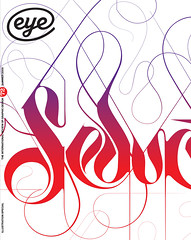Summer 2009
The chemistry that created a winning Swiss formula
Good Design, Good Business: Swiss Graphic Design and Advertising by Geigy, 1940-1970
Museum fur Gestaltung Zurich, Switzerland<br>4 February – 24 May 2009<br>Where did the ‘Swiss style’ come from?
The book Corporate Diversity answers the question: it was established more firmly in Basel than in Zurich. This account of design at Geigy, a vast chemical company with headquarters in Basel (and now part of the Novartis pharmaceutical conglomerate), was made to accompany an exhibition at the Zurich Design Museum. Both book and exhibition fill out our understanding of Swiss design, carry a message about corporate identity, and show a huge variety of work, some familiar from reproduction, some hardly seen before.
The exhibition ‘Good Design, Good Business’ presented printed work, brochures, advertisements and packaging in triangular-faceted showcases suggesting a chemical crystalline structure. These provided vertical and horizontal places for display, and housed small screens for the company’s promotional films. Arranged by categories, some on product areas such as pest control (including the company’s Nobel Prize-winning insecticide DDT) or dyestuffs. The exhibition began with advertising, went on with sections on techniques – for example, symbolism, photographics, typography – and gave an account of Geigy’s graphics in other countries. Similar divisions appear in the book, which starts with six essays followed by five sections of illustrations and extended captions: ‘Advertising Campaigns’, ‘Series’, ‘Diversity’, ‘Packaging’ and ‘Prestige’.
The titles of the exhibition and the book show their dual aim: not only to examine the firm’s design in its marketing, but also to place it in the development of Swiss graphic design. Such a project, presenting a large amount of material from a period of 30 years, demands a clear sequence and structure. Yet the thematic arrangement chosen here, interrupted by random insertions of classic Swiss graphics, leaves both visitors and readers to piece together the development of the Geigy style in the absence of a clear timeline.
In the first of the six essays that begin the book, the Zurich Design Museum’s curator, Andres Janser, connects the roles of the advertising manager, the art director and the designers. In the art director Max Schmid, Geigy was blessed with a brilliant designer who recognised young talent and employed it. The link between Geigy and Basel’s Allgemeine Gewerbeschule was crucial. In Armin Hofmann and Emil Ruder the school had two of the most brilliant designer teachers of their generation. Lessons learned in their classes were put to use at Geigy in masterly compressions of hidden anatomy, simplified graphics of complex processes, precise and elegant typography. And the most remarkable aspect of the work is that there was no Geigy house style, no manual such as is now considered necessary to a corporate identity. In her essay on the American end of the operation, Karin Gimmi quotes its New York art director, Fred Toller, in 1966: ‘The “Swiss-like” style of Geigy is in reality neither Swiss nor a style. It is the evolutionary result of years of experimentation and discover, and it is even at this moment undergoing a metamorphosis. It is more properly described as a more functional approach to design.’
The work of the Geigy studios in the US and England is one of the most remarkable revelations of the book and the exhibition. Though some of the American work is certainly un-Swiss in its free inventiveness – exemplified in work by Georg Giusti and the Geigy house magazine, Catalyst – the influence of Swiss graphic design in corporate America went well beyond the Geigy era, as another essay shows. If there was a recognisable Geigy style, then it was more consistently applied in England after the company opened a studio at its offices near Manchester. This was run by the British designer Colin Smythe, who had worked under Max Schmid in Basel and at the New York office. Although mostly staffed by graduates of Manchester College of Art and Design, personnel exchanges with Basel and the use of Akzidenz-Grotesk meant that there was little to distinguish the Manchester design work from that originating in Switzerland.
The Geigy style was due to the consistent quality of design and a common view of what constituted Good Design and who could do it. The number of celebrated Swiss designers who worked for the firm in the 1960s is astonishing. As well as Schmid, they included Karl Gerstner, Armin Hofmann, Gottfried Honegger, Stephan Geissbühler, George Giusti, the photographer René Groebli, Jörg Hamburger, Andres His, Gérard Ifert, Warja Honegger-Lavater, Fridolin Müller, Thérèse Moll, Enzo Roesli, Nelly Rudin, Albe Steiner and Fred Troller. Their work for Geigy underlines the claim that ‘Swiss’ graphic design established itself first in Basel.
The anaemic, retro-style layout of the book, with illustrations scattered far from their reference in the text, makes a sad contrast with the logic and elegance of the best Geigy typography. But there is compensation for the loose control of curators and editors. The richness of the work shown, the wide range of the essays, the extensive footnotes and fine bibliography make Corporate Diversity a useful addition to our understanding of ‘Swiss style’.
First published in Eye no. 72 vol. 18 2009
Eye is the world’s most beautiful and collectable graphic design journal, published quarterly for professional designers, students and anyone interested in critical, informed writing about graphic design and visual culture. It is available from all good design bookshops and online at the Eye shop, where you can buy subscriptions and single issues.

